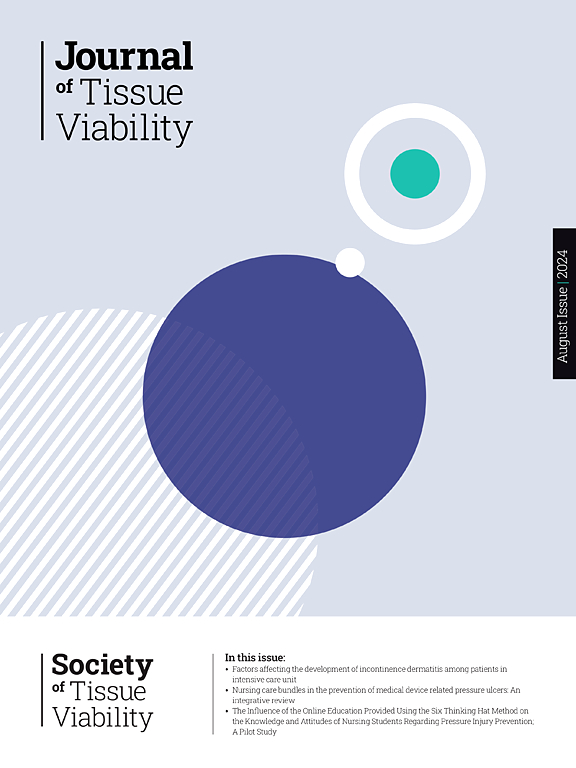振动疗法治疗难以愈合的伤口:实验研究的系统回顾和荟萃分析。
IF 2.4
3区 医学
Q2 DERMATOLOGY
引用次数: 0
摘要
简介:难以愈合的伤口会导致功能丧失,生活质量下降,并因愈合延迟而延长住院时间。处理这类伤口的医疗费用是巨大的。振动疗法已被提出作为难以愈合伤口的替代治疗方法,但尚未有全面的文献对其疗效进行定量分析。材料与方法:系统检索6个数据库,于2024年8月1日检索相关文章。纳入分析的研究方法采用Cochrane第2版随机试验偏倚风险工具和ROBINS-I非随机研究工具进行评估。随机效应模型用于汇总汇总效应大小。采用I2评估异质性。生成森林图进行meta分析。结果:meta分析纳入了10项研究。振动治疗可显著减轻神经病变(合并标准化平均差[SMD] = -0.79;95% CI = -1.51 ~ -0.07;p = 0.03;I2 = 61.40%),溃疡愈合面积增大(合并SMD = 0.92;95% CI = 0.60 ~ 1.23;P 2 = 0.00 %)。然而,干预并没有显著缓解疼痛(综合SMD = -0.51;95% CI = -1.38 ~ 0.36;p = 0.25;i2 = 74.15%)。在疼痛和神经病变的汇总结果中发现了显著的异质性。结论:振动疗法可促进溃疡愈合,减轻神经病变。这些结果可能有助于研究人员和医疗保健提供者进一步发展振动疗法,以解决弥合伤口护理中证据与实践差距的潜在需求。未来的研究应考虑振动治疗的安全性和潜在的不良后果,以确保其适用于治疗难以愈合的伤口。本文章由计算机程序翻译,如有差异,请以英文原文为准。
Vibration therapy for patients with hard-to-heal wounds: A systematic review and meta-analysis of experimental studies
Introduction
Hard-to-heal wounds lead to functional loss, decreased quality of life, and prolonged hospitalization due to delayed healing. The healthcare costs of managing such wounds are substantial. Vibration therapy has been proposed as an alternative treatment for hard-to-heal wounds but no comprehensive reviews have quantitatively analyzed its efficacy.
Materials and methods
Six databases were systematically searched for relevant articles on August 1, 2024. The methodologies of the studies included in the analysis were assessed using Version 2 of the Cochrane Risk of Bias tool for randomized trials and ROBINS-I tool for non-randomized studies. A random-effects model was applied to aggregate the pooled effect size. Heterogeneity was assessed using I2. A forest plot was generated for meta-analysis.
Results
Ten studies were included in the meta-analysis. Vibration therapy significantly reduced neuropathy (pooled standardized mean difference [SMD] = −0.79; 95 % CI = −1.51 to −0.07; p = 0.03; I2 = 61.40 %) and enhanced the ulcer healing area (pooled SMD = 0.92; 95 % CI = 0.60 to 1.23; p < 0.001; I2 = 0.00 %) of patients with hard-to-heal wounds. However, the intervention did not significantly alleviate pain (pooled SMD = −0.51; 95 % CI = −1.38 to 0.36; p = 0.25; I2 = 74.15 %). Significant heterogeneity was identified in the pooled result for pain and neuropathy.
Conclusions
Vibration therapy appears to enhance ulcer healing and reduce neuropathy. These results may help researchers and healthcare providers to further develop vibration therapy to address the underlying requirements for bridging the evidence–practice gap in wound care. Future studies should consider the safety and potential adverse outcomes of vibration therapy to ensure its appropriate application for treating hard-to-heal wounds.
求助全文
通过发布文献求助,成功后即可免费获取论文全文。
去求助
来源期刊

Journal of tissue viability
DERMATOLOGY-NURSING
CiteScore
3.80
自引率
16.00%
发文量
110
审稿时长
>12 weeks
期刊介绍:
The Journal of Tissue Viability is the official publication of the Tissue Viability Society and is a quarterly journal concerned with all aspects of the occurrence and treatment of wounds, ulcers and pressure sores including patient care, pain, nutrition, wound healing, research, prevention, mobility, social problems and management.
The Journal particularly encourages papers covering skin and skin wounds but will consider articles that discuss injury in any tissue. Articles that stress the multi-professional nature of tissue viability are especially welcome. We seek to encourage new authors as well as well-established contributors to the field - one aim of the journal is to enable all participants in tissue viability to share information with colleagues.
 求助内容:
求助内容: 应助结果提醒方式:
应助结果提醒方式:


